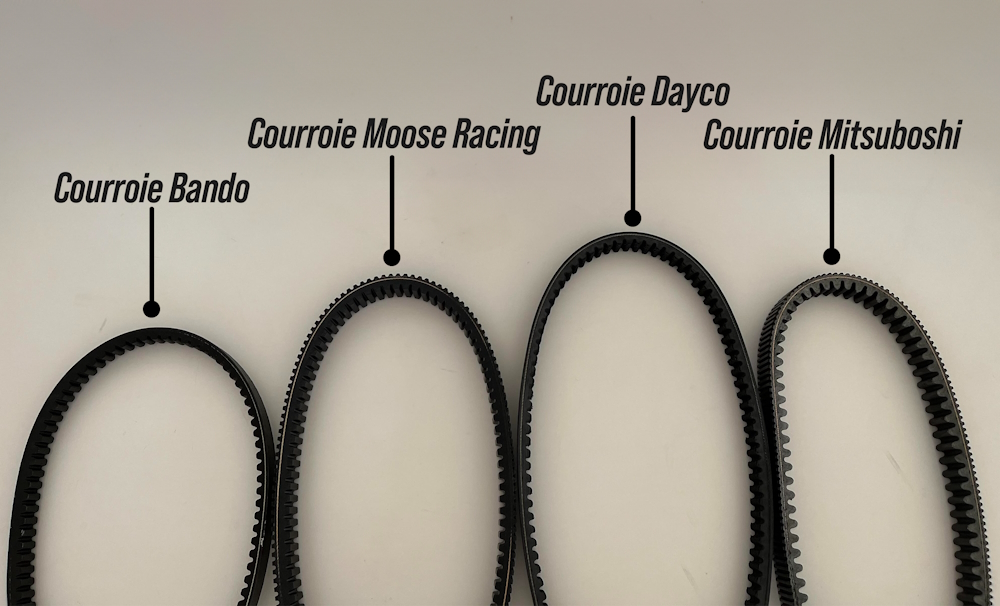
How to choose the right transmission belt for your quad?
A loss of performance, a slipping engine, noises coming from the clutch are the signs of a weakness in the transmission belt. It is high time to check it and probably change it.
The CVT (continuously variable transmission) transmission usually consists of a belt, a primary clutch (“clutch”) which is coupled directly to the engine crankshaft and a secondary clutch (“driven”). ) which transmits the power to the transmission input. This set of pulleys connected par a belt continuously modifies the ratio par their opening and closing movement.
Mechanically, the quad variators use the very simple principle of those which equip scooters, with the combination of two pulleys (receiver receiving the movement of the motor and motor transferring the movement to the wheels) connected ©es par a belt, the driving pulley being associated with a centrifugal clutch. The variator is par elsewhere completed par a mechanical gearbox offering two forward and one reverse ranges.
Measure your belt
First, start par measure the different sides of your belt. Ideally, use a caliper to measure length (A), height (B) and thickness (C). Once you have noted these measurements, you can easily find the replacement belt you need.

The transmission belts fitted to quad variators do not require tension adjustment, and almost zero maintenance. EThey must be replaced regularly depending on the driving and use of your quad.
Don't forget to check it from time to time to prevent it from breaking during use, causing you a significant risk of falling and costly repairs.
Discover our range of belts for quads on 50factory. Com.
To choose the right belt, measure the length, width and thickness of your old belt.
Belt Features
Resistance but also flexibility are the characteristics of the transmission belt. To force to be stretched under the stresses of acceleration or to force to slide against the "cheeks" of the variator, the resistance of the rubber eventually par diminish. The wear accelerates to the point that the structure of the belt itself sometimes ends up being damaged.ar appear.
The toothed V-belt works like a chain but with more flexibility. On the other hand, it supports low speeds and requires a lower initial tension;
The transmission belt located on a quad is made of durable, reinforced rubber par a metallic mesh or aramid fibers (Kevlar) which is particularly resistant to the wear and tear of time.
Not requiring any special maintenance or even lubrication, the belt must however be changed fairly regularly. Its lifespan is approximately 10 km. The use and way you ride your quad increases or decreases the life of the belt.
Maintenance, advice and changing the belt
On many quads, it is possible to check the condition of the belt yourself, unless of course you do not have the slightest tool or your mechanical skills are non-existent. Manufacturers recommend checking the condition of the belt approximately every 6000 km.
For comparison, a motorcycle chain must be lubricated and tensioned every 1000 km, to be replaced every 20000 km at most.
It is essential to use the short range of the transmission, in order to benefit from better torque and to ensure good cooling of the variator. More generally, it is recommended to use the short range for all low speed, traction and crossing work. The rest of the time, it is possible to stay in long range, in particular to reach maximum speed.
Thanks to our tutorial, you will be able to check the condition of your belt.
To access the belt, all you have to do is remove the protective cover from the belt. Once the latter has been removed, you will be able to judge on the level of general cleanliness if the belt begins to show its first signs of weakness; in fact, a nice thickness of black dust will then have accumulated in the crankcases.
It is also necessary to check the elasticity of the belt.
Check that the belt does not fray, that there are no cracks. Check its general appearance.

Replacing the belt, on the other hand, is a more complex operation.
Replacing the transmission belt is a fairly common operation in the maintenance of a quad. Follow the instructions on tutorial complete par le video tutorial.
The belts are defined par their length, angle and type of material. Manufacturers offer original or reinforced belts. Reinforced belts (Kevlar, etc.) providing better performance and less wear par compared to those of the original type.
A belt that is too lightly tensioned slips and makes noise, heats up tremendously and suffers premature wear, all causing the accessories driven to malfunction.ar the belt. Excess tension generates excessive wear of the latter.
Likewise, when your belt is worn or slack, it no longer rubs properly on the pebble and this manifests itself par a significant squeak.
To make the right choice, you will need to know the type of section as well as the dimensions of the belt.
In order to determine what type of V-belt you need you will need to measure the width and thickness of it as shown in the diagram above, but also the exterior length which, once the type is determined, will allow you to find the model you are looking for.











